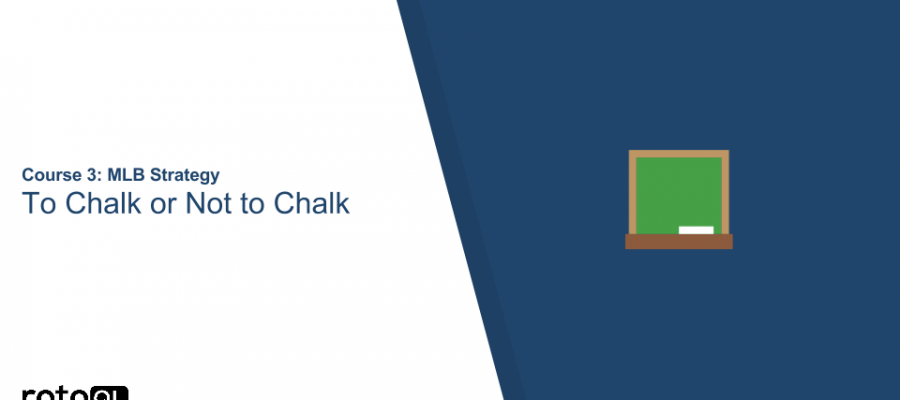Advice on How to Pick Chalk Players in Daily Fantasy Baseball
Posted on August 2, 2016
Here at the RotoQL blog we have made it our mission to prepare our users with a DFS MLB lineup advice for the start of the season and beyond.
There are many different strategies one can use when playing daily fantasy baseball. One such strategy is the plan of chalking when constructing your lineups. In this article, we are going to discuss Saahil’s advice on how to pick chalk players in MLB DFS. We will give an overview of what chalking is, factors behind player ownership, and how it affects your MLB DFS strategy. Let’s get to it.
Chalk Players: Daily Fantasy Baseball Overview
First of all, what is a chalk player? Chalk players are the more obvious favorites that people select for their DFS MLB lineups. They are highly owned, in both cash games and tournaments, because they are expected to perform well. A chalk player is generally owned in at least 25% in tournaments and cash games. For example, if Bryce Harper is owned in seven out of 10 lineups, he would be considered to be 70% owned, and thus a very, very “chalky” player. As you can tell, finding chalk players in MLB daily fantasy is not difficult.
There are different strategies to take in terms of chalk players depending on if you are playing in a cash game or in a tournament. In cash lineups, chalk players are essentially a necessity. They are considered safe picks that should perform well, so several chalk players should be in your lineup. There is no downside to including chalk players in your cash lineups. Whenever you think a chalk player is a good pick, do not hesitate to include him in your lineups, without worrying about ownership too much. However, the same strategy should not be used in tournaments. In tournament lineups, you want to consider chalk players a little more closely than in cash lineups. Since chalk players are highly owned, if you ignore them or evade them in some instances and they do not perform well, you will really be able to take advantage of that and your lineups will shoot to the top. But the reason chalk players are considered chalk players is because they are expected to perform well. So you should include some chalk in your lineup, but at the same time, you should take risks and go against the grain in some slots.
Factors Behind Ownership
There are several factors behind ownership of chalk players. The first, as we have discussed in other strategy articles, is Vegas. Vegas data, such as the Over/Under and the Predicted Runs, will have an effect on a player’s ownership. The next factor is the matchup (which is included in some of the Vegas data). By matchup, we are talking about some of the more obvious match ups. For example, if Stephen Strasburg is starting, the hitters on the other team will likely be lowly owned. Value is another factor behind ownership. If a player is starting and is still really cheaply priced, he is likely to be pretty highly owned.
Where the game is taking place is also an important factor towards a player’s ownership. Hitters playing in hitter-friendly parks (such as Coors Field) are going to almost always be highly owned. The same can be said for pitchers in pitcher-friendly parks. If a solid pitcher is taking the mound in San Diego at Petco Park, he is likely to be highly-owned. So the ballpark is a big deciding factor behind a player’s ownership. The next factor is QL Wire Content. If you look at all the articles we have on the QL Wire, players that frequently show up in multiple articles are likely to be highly owned as chalk players.
Another thing that affects a player’s ownership is streaky play. If a player has one or two consecutive good games, people’s short-term memory will affect the player’s ownership. After one good game, a player’s ownership will jump about 3% more. After two or three games, that number will jump to 4 or 5%. If you have a player on a big hot streak, he will most likely continue to be highly owned until he cools down.
How Picking Chalk Players Affects your DFS MLB Strategy
Now that you know what chalking is, and the factors behind what makes a player a chalk player, it’s time to implement it into your DFS MLB strategy. Saahil gives great advice on how to pick chalk players in MLB DFS, and what type of matchups you should take advantage of. The first situation in which you want to select a chalk player is when a top player has a truly great matchup. For example, a healthy Clayton Kershaw starting at Petco Park in San Diego is just about the best pitcher and matchup you can ask for. Kershaw’s ownership in that matchup earlier in the season was 35%. A top pitcher starting in an incredibly pitcher-friendly park is one situation in which you want to chalk.
Another situation in which you would want to choose to chalk is if a backup player moves into the leadoff spot (or near the top of the batting order). An example of this is Miami’s Derek Dietrich replacing Dee Gordon in the leadoff spot for the Marlins. In this situation, Dietrich is replacing a star player, and thus his salary is likely to be low. As the leadoff hitter, he will get the maximum amount of opportunities to score fantasy points. Dietrich’s ownership in this situation earlier in the season was 50%. But at a low salary, this is a good value pick. Another great time to chalk players in tournaments is when you like correlated players (or players on the same team). If a certain team has a good hitting lineup and has a great matchup that night, picking a few correlated players could prove to be very successful.
Just as there are situations in which you want to select chalk players, there are times in which it would be best to fade chalk players out of your lineup. Baseball is a high volatility sport, so fading the chalk would make more sense than it would in a sport like basketball. The method Saahil uses to find chalk players in MLB daily fantasy to fade is when ownership is greater than the probability of high output. Going back to one of our prior examples, if Dietrich’s probability of being a top value play is 20%, and his projected ownership is 40%, then you want to try to fade him. But if his probability of being a top value play was 60%, and his projected ownership is 40%, then you should definitely try to include him in a lot of your lineups. When it comes to pitchers, the top ones will almost always have a high probability of being a top value play. As long as their projected ownership doesn’t match this high percentage, you should try to get these pitchers into your lineups.
Make sure to check out RotoQL for daily fantasy football. Pro Football Focus projections to create the best NFL lineups with RotoQL’s real-time NFL lineup optimizer. Our premium subscription includes NFL lineup optimizer for DraftKings and FanDuel 50/50s and GPPs.



